tire pressure PONTIAC BONNEVILLE 1995 Owners Manual
[x] Cancel search | Manufacturer: PONTIAC, Model Year: 1995, Model line: BONNEVILLE, Model: PONTIAC BONNEVILLE 1995Pages: 338, PDF Size: 16.19 MB
Page 115 of 338
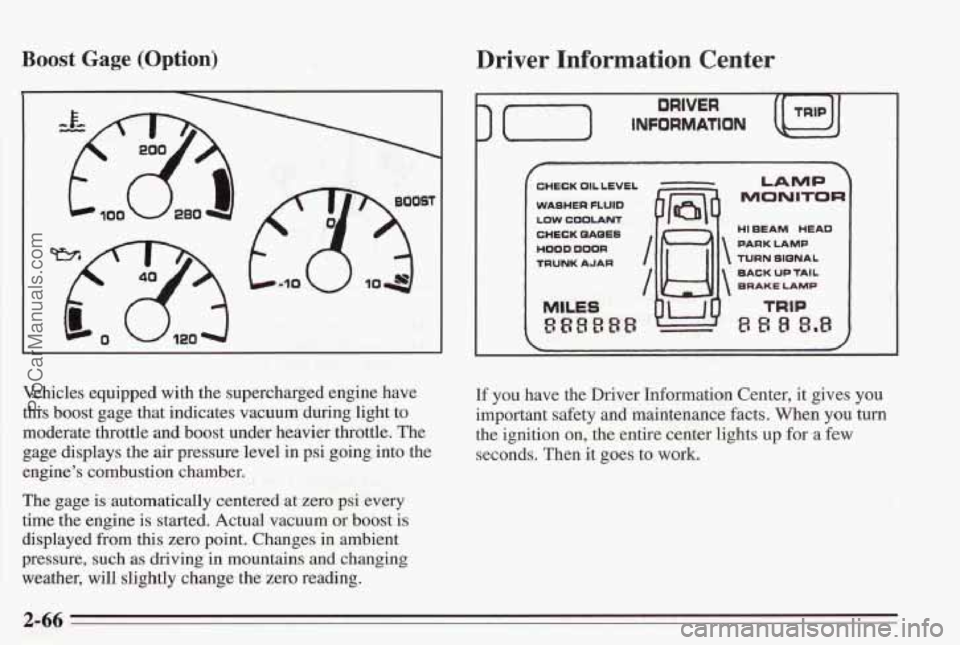
Boost Gage (Option)
Vehicles equipped with the supercharged engine have
this boost gage that indicates vacuum during light to
moderate throttle and boost under heavier throttle. The
gage displays the air pressure level in psi going into the
engine’s combustion chamber.
The gage is automatically centered at zero psi every
time the engine is started. Actual vacuum or
boost is
displayed from this zero point. Changes in ambient
pressure, such
as driving in mountains and changing
weather, will slightly change the zero reading.
Driver Information Center
) (-) INFORMATION
DRIVER
CHECK OIL LEVEL
WASHER
FLUID
LOW COOLANT
CHECK QAQES
HOOD DOOR
TRUNK AJAR
MILES
888888
I /w
7
LAMP
MONITOR
HI EEAM HEAD
PARK LAMP
TURN SIQNAL
BACK
UP TAIL
BRAKE LAMP
If you have the Driver Information Center, it gives you
important safety and maintenance facts. When you turn
the ignition on, the entire center lights
up for a few
seconds. Then it goes to work.
2-66
ProCarManuals.com
Page 150 of 338
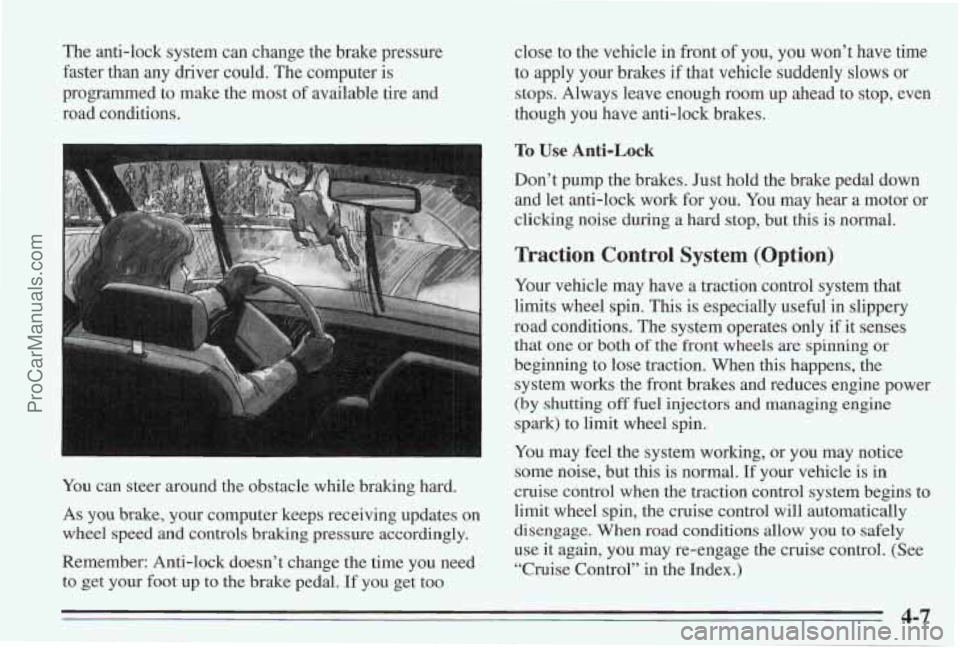
The anti-lock system can change the brake pressure
faster than any driver could. The computer is
programmed to make the most of available tire
and
road conditions.
You can steer around the obstacle while braking hard.
As you brake, your computer keeps receiving updates on
wheel speed and controls braking pressure accordingly.
Remember: Anti-lock doesn’t change the time you need
to get your foot up to the brake pedal. If you get too close to
the vehicle in front of you,
you won’t have time
to apply your brakes if that vehicle suddenly slows or
stops. Always leave enough room up ahead
to stop, even
though you have anti-lock brakes.
To Use Anti-Lock
Don’t pump the brakes. Just hold the brake pedal down
and let anti-lock work for you.
You may hear a motor or
clicking noise during a hard stop, but this is normal.
Traction Control System (Option)
Your vehicle may have a traction control system that
limits wheel
spin. This is especially useful in slippery
road conditions. The system operates only if it senses
that one or
both of the front wheels are spinning or
beginning to lose traction. When this happens, the
system works the front brakes and reduces engine power
(by shutting off fuel injectors and managing engine
spark) to limit wheel spin.
You may feel the system working, or you may notice
some noise, but this is normal. If your vehicle is in
cruise control when the traction control system begins to
limit wheel spin, the cruise control will automatically
disengage. When road conditions allow you
to safely
use it again, you may re-engage the cruise control. (See
“Cruise Control” in the Index.)
4-7
ProCarManuals.com
Page 161 of 338
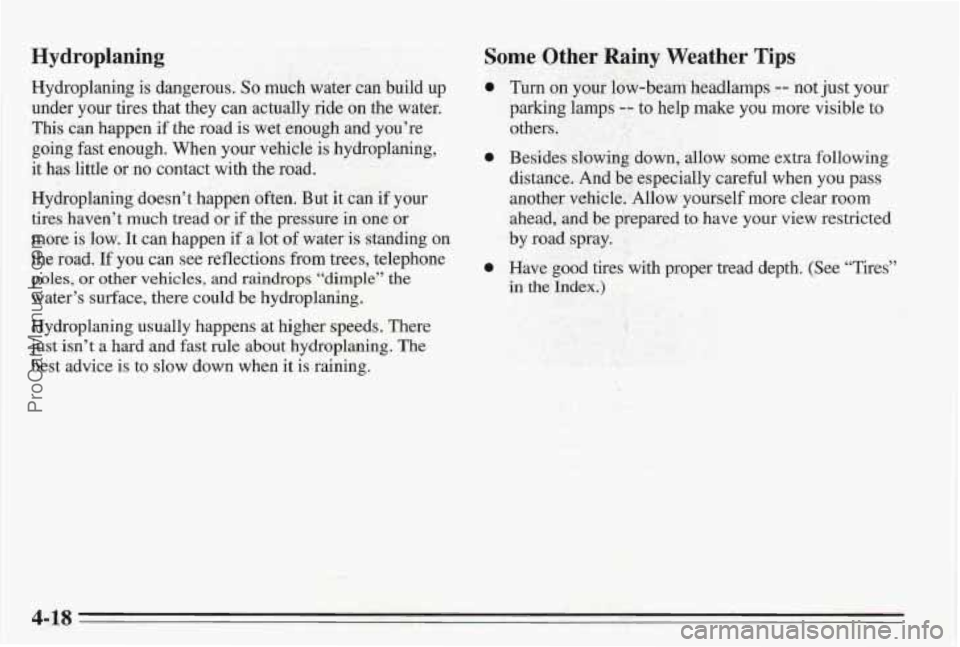
Hydroplaning
Hydroplaning is dangerous. So much water can build up
under your tires that they can actually ride on the water.
This can happen if the road is wet enough
and you’re
going fast enough. When
your vehicle is hydroplaning,
it has little or no contact with the road.
Hydroplaning doesn’t happen often. But it can
if your
tires haven’t much tread or if the pressure
in one or
more is low. It can happen if a lot
of water is standing on
the road. If you can see reflections from trees, telephone
poles, or other vehicles, and raindrops “dimple” the
water’s surface, there could be hydroplaning.
Hydroplaning usually happens at higher speeds. There
just isn’t
a hard and fast rule about hydroplaning. The
best advice
is to slow down when it is raining.
,.<, ., .- ’ ,”.’ ’ - ’ .. c ,. . - :. .
Some Other Rainy Weather Tips
0 Turn on your low-beam headlamps -- not just your
parking lamps
-- to help make you more visiblle to
others.
0 Besides slowing down, allow some extra following
distance. And
be especially carefial when you pass
another vehicle. Allow yourself more clear room
ahead,
and be prepared to have your view restricted
by road spray.
0 Have good tires with proper tread depth. (See “Tires”
in the Index.)
4-18
ProCarManuals.com
Page 164 of 338
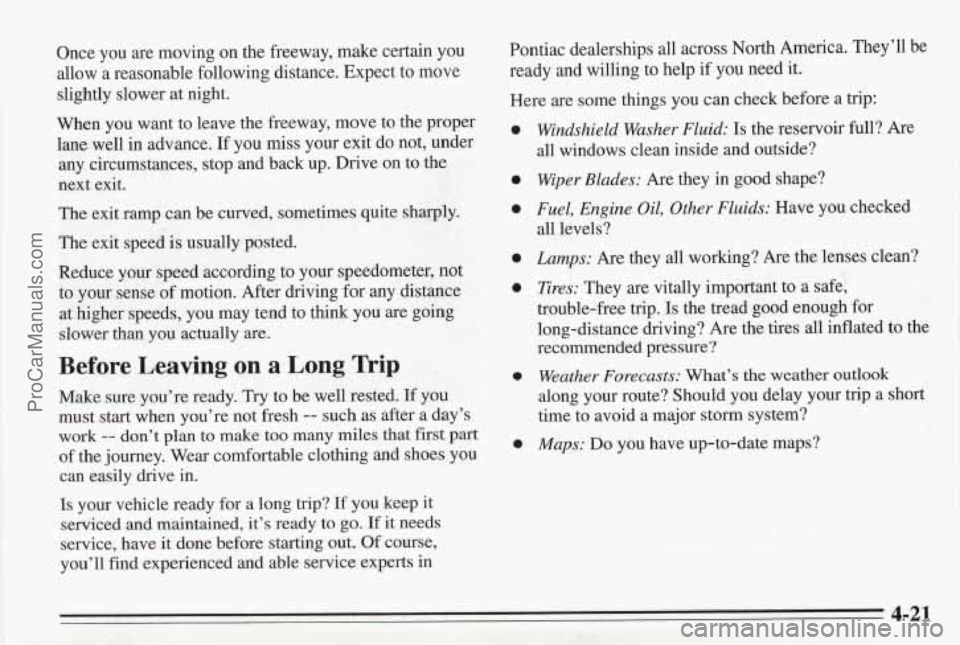
Once you are moving on the freeway, make certain you
allow a reasonable following distance. Expect to move
slightly slower
at night.
When you want to leave the freeway, move to the proper
lane well in advance.
If you miss your exit do not, under
any circumstances, stop and back up. Drive on to the
next exit.
The exit ramp can be curved, sometimes quite sharply.
The exit speed is usually posted.
Reduce your speed according to your speedometer, not
to your sense
of motion. After driving for any distance
at higher speeds, you may tend to think you are going
slower than you actually are.
Before Leaving on a Long Trip
Make sure you’re ready. Try to be well rested. If you
must start when you’re not fresh
-- such as after a day’s
work
-- don’t plan to make too many miles that first part
of the journey. Wear comfortable clothing and shoes you
can easily drive in.
Is your vehicle ready for a long trip? If you keep it
serviced and maintained, it’s ready to go. If it needs
service, have
it done before starting out. Of course,
you’ll find experienced and able service experts in Pontiac dealerships
all across North America. They’ll be
ready and willing to help if you need it.
Here are some things you can check before a trip:
0
0
0
e
0
0
0
Windshield Washer Fluid: Is the reservoir full? Are
all windows clean inside and outside?
Wiper Blades: Are they in good shape?
Fuel, Engine Oil, Other Fluids: Have you checked
all levels?
Lamps: Are they all working? Are the lenses clean?
Tires: They are vitally important to a safe,
trouble-free trip.
Is the tread good enough for
long-distance driving? Are the tires all inflated
to the
recommended pressure?
Weather Forecasts: What’s the weather outlook
along your route? Should you delay your trip a short
time to avoid a major storm system?
Maps: Do you have up-to-date maps?
4-21
ProCarManuals.com
Page 171 of 338

Then, shut the engine off and close the window almost
all the way to preserve the heat. Start the engine again
and repeat this only when you feel really uncomfortable
from the cold. But do it as little as possible. Preserve the
fuel as long as
you can. To help keep wm, you can get
out of the vehlcle and do some fairly vigorous exercises
every half hour or
so until help comes.
Loading Your Vehicle
d OCCUPANTS VEHICLE CAP. WT.
FRT. CTR. RR. TOTAL LBS. KG
TIRE-LOADING INFORMATION
MAX.
LOADING & GVWR SAME AS VEHICLE
CAPACITY WEIGHT XXX COLD TIRE
TIRE SIZE SPEED PRESSURE
RTG
PSI/KPa
FRT.
RR.
SPA.
IF TIRES ARE HOT, ADD 4PS1/28KRa
SEE OWNER‘S MANUAL FOR ADDITIONAL
INFORMATiON
Two labels on your vehicle show how much weight it
may properly carry. The Tire-Loading Information label
found on the rear edge
of the driver’s door tells you the proper
size, speed rating
and recommended inflation
pressures for the tires
on your vehicle. It also gives you
important information about the number
of people that
can be in your vehicle
and the total weight that you can
carry. This weight is called the Vehicle Capacity Weight
and includes the weight of all occupants, cargo, and all
nonfactory-installed options.
MFD BY GENERAL MOTORS CORP
DATE GVWR GAWR FRT GAWR RR
THIS VEHICLE CONFORMS TO ALL APPLI-
CABLE U.S. FEDERAL MOTOR VEHICLE
SAFETY,
BUMPER, AND THEFT PREVENTION
STANDARDS
IN EFFECT ON THE DATE OF
MANUFACTURE SHOWN ABOVE.
The other label is the Certification label, found on the
rear edge
of the driver’s door. It tells you the gross
weight capacity
of your vehicle, called the GVWR
(Gross Vehicle Weight Rating). The GVWR includes the
weight of the vehicle,
all occupants, fuel and cargo.
4-28
ProCarManuals.com
Page 175 of 338
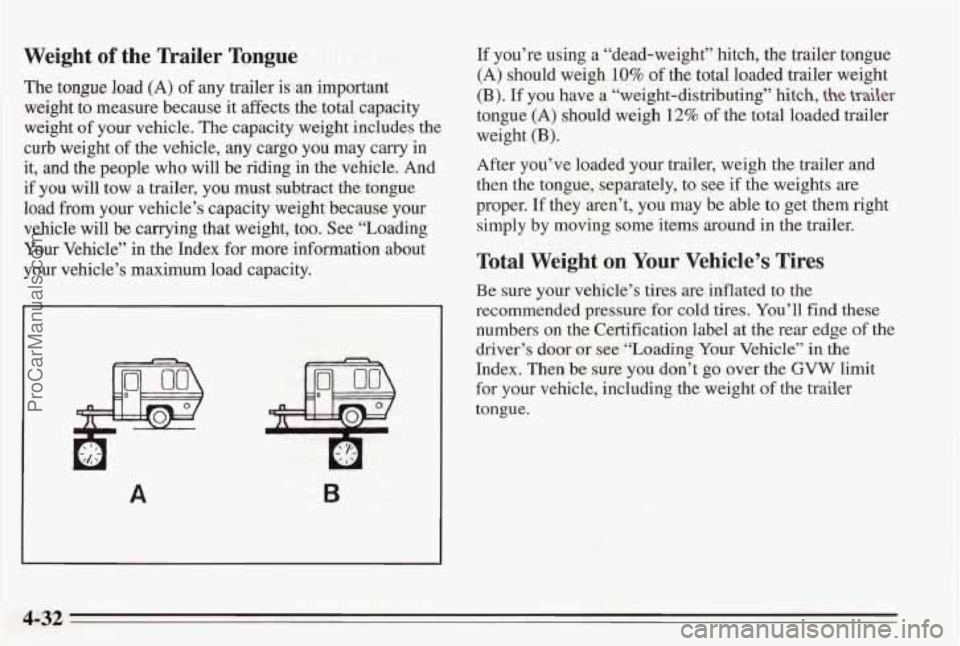
Weight of the Trailer Tongue
The tongue load (A) of any trailer is an important
weight to measure because it affects the total capacity
weight of your vehicle. The capacity weight includes the
curb weight of the vehicle, any cargo you may carry in
it, and the people who will be riding
in the vehicle. And
if you will tow a trailer, you must subtract the tongue
load from
your vehicle’s capacity weight because your
vehicle will be carrying that weight, too. See “Loading
Your Vehicle” in the Index for more information about
your vehicle’s maximum load capacity.
If you’re using a “dead-weight’’ hitch, the trailer tongue
(A) should weigh 10% of the total loaded trailer weight
(B). If you have a “weight-distributing” hitch, the tmik
tongue (A) should weigh 12% of the total loaded trailer
weight
(B).
After you’ve loaded your trailer, weigh the trailer and
then the tongue, separately, to see if the weights are
proper.
If they aren’t, you may be able to get them right
simply by moving some items around in the trailer.
Total Weight on Your Vehicle’s Tires
Be sure your vehicle’s tires are inflated to the
recommended pressure for cold tires. You’ll find these
numbers on the Certification label at the rear edge of the
driver’s door
or see “Loading Your Vehicle” in the
Index. Then be sure you don’t go over the GVW limit
for your vehicle, including the weight
of the trailer
tongue.
4-32
ProCarManuals.com
Page 200 of 338
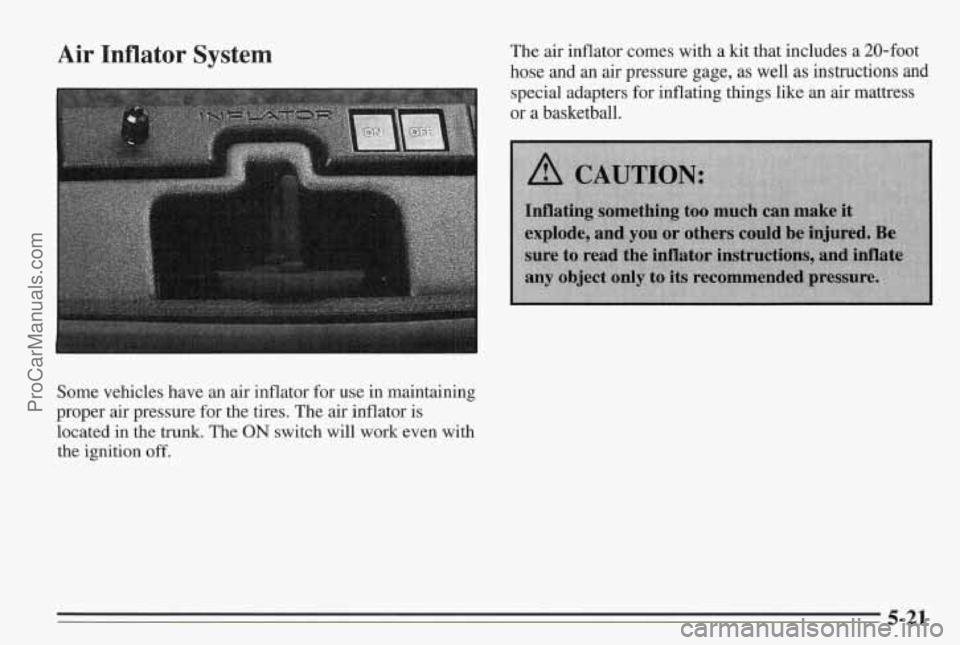
Air Inflator System
Some vehicles have an air inflator for use in maintaining
proper air pressure
for the tires. The air inflator is
located in the
trunk. The ON switch will work even with
the ignition
off.
The air inflator comes with a kit that includes a 20-foot
hose and an air pressure gage, as well as instructions and
special adapters for inflating things like an air mattress
or
a basketball.
5-21
ProCarManuals.com
Page 211 of 338

Compact Spare Tire
Although the compact spare was fully inflated when
your vehicle was new,
it can lose air after a time. Check
the inflation pressure regularly.
It should be 60 psi
(420 Wa). After installing the compact spare on your
vehicle,
you should stop as soon as possible and make
sure your spare tire
is correctly inflated. The compact
spare is made
to perform well at posted speed limits for
distances up to
3,000 miles (5 000 km), so you can
finish your trip
and have your full-size tire repaired or
replaced where you want.
Of course, it’s best to replace
your spare with a full-size tire as soon as yon can. Your
spare will last longer and be in good shape in case you
need
it again.
NOTICE:
Don’t take your compact spare through an
automatic car wash with
guide rails. The
compact spare can get caught
on the rails. That
can damage the
tire and wheeI, and maybe other
parts of your vehicle.
Don’t use your compact spare on some other vehicle.
And don’t
mix your compact spare or wheel with other
wheels
or tires. They won’t fit. Keep your spare and its
wheel together.
NOTICE:
Tire chains won’t fit your compact spare. Using
them will damage your vehicle and destroy the
chains too. Don’t use tire chains on your compact
spare.
5-32
ProCarManuals.com
Page 247 of 338
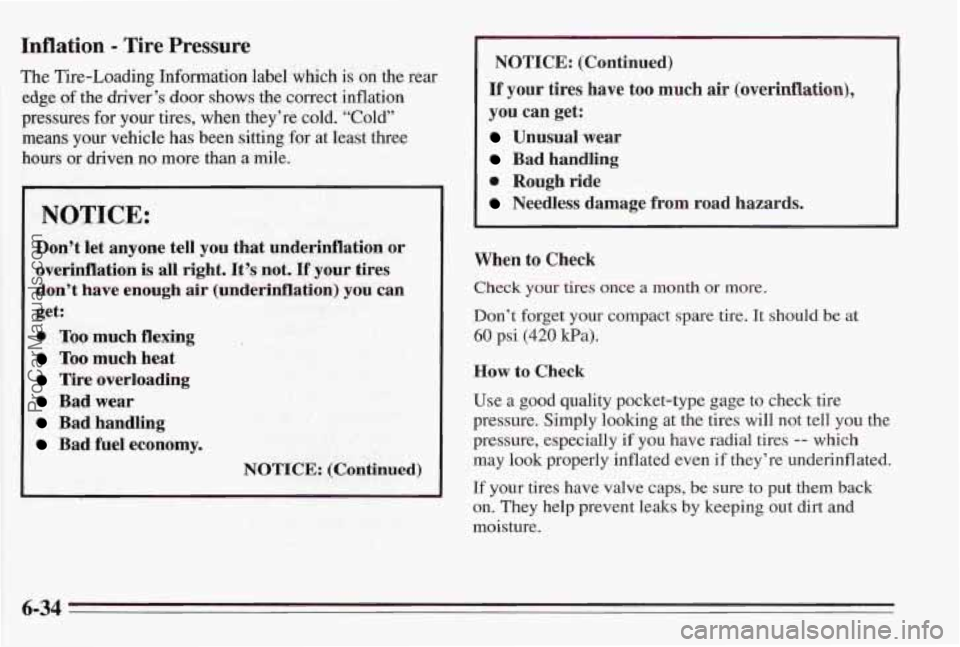
Inflation - Tire Pressure
The Tire-Loading Information label which is on the rear
edge
of the driver’s door shows the correct inflation
pressures for your tires, when they’re cold.
“Cold”
means your vehicle has been sitting for at least three
hours or driven no more than a mile.
NOTICE:
Don’t let anyone tell you that un’derinflation or
overinflation is all right. It’s not. If your tires
don’t
have enough air (underinflation] you can
get:
0 Too much flexing ’ i . ’:+?,,%
Too much heat
Tire overloading
Bad wear
Bad handling
Bad fuel economy.
. . . .> .’“’
NOTICE: (Continued)
NOTICE: (Continued)
If’ your tires have too much air (overinflation),
you can get:
Unusual wear
Bad handling
0 Rough ride
Needless damage from road hazards.
When to Check
Check your tires once a month or more.
Don’t forget your compact spare tire. It should be at
60 psi (420 Pa).
How to Check
Use a good quality pocket-type gage to check tire
pressure. Simply looking at the tires will not tell you the
pressure, especially if you have radial tires
-- which
may look properly inflated even if they’re underinflated.
If your tires have valve caps, be sure to put them back
on. They help prevent leaks by keeping
out dirt and
moisture.
6-34
ProCarManuals.com
Page 248 of 338

Tire Inspection and Rotation
Tires should be inspected every 6,000 to 8,000 miles
(10 000 to 13 000 km) for any signs of unusual wear. If
unusual wear is present, rotate your tires as soon as
possible and check wheel alignment. Also check for
damaged tires or wheels. See “When it’s Time for New
Tires” and “Wheel Replacement” later in this section for
more information.
The purpose of regular rotation is to achieve more
uniform wear for all tires
on the vehicle. The first
rotation is the most important. See “Scheduled
Maintenance Services” in the Index for scheduled
rotation intervals.
I 1 1 - I
When rotating your tires, always use the correct rotation
pattern shown here. Don’t include
the compact spare tire in your tire
rotation.
After the tires have been rotated, adjust the front and
rear inflation pressures as shown on the Tire-Loading
Information label. Make certain that all wheel nuts are
properly tightened. See “Wheel Nut
Torque” in the
Index.
6-35
ProCarManuals.com